
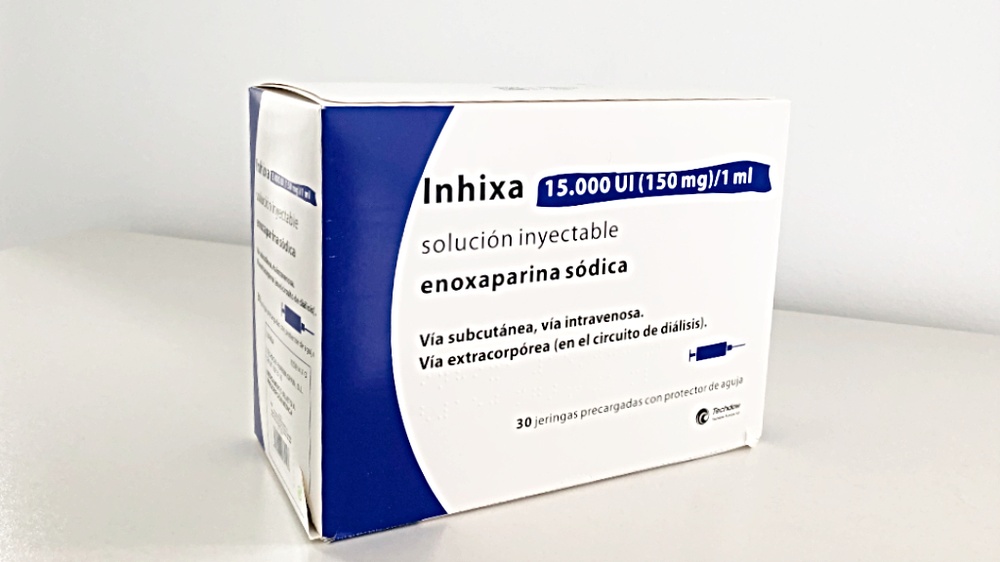
ІНІКСА 15 000 МО (150 мг)/1 мл розчин для ін'єкцій

Запитайте лікаря про рецепт на ІНІКСА 15 000 МО (150 мг)/1 мл розчин для ін'єкцій

Інструкція із застосування ІНІКСА 15 000 МО (150 мг)/1 мл розчин для ін'єкцій
Введення
Опис: інформація для користувача
Inhixa 12 000 ОД (120 мг)/0,8 мл розчин для ін'єкцій
Inhixa 15 000 ОД (150 мг)/1 мл розчин для ін'єкцій
Еноксапарин содій
Прочитайте уважно весь опис перед тим, як почати використовувати цей лікарський засіб, оскільки він містить важливу інформацію для вас.
- Збережіть цей опис, оскільки вам може знадобитися знову його прочитати.
- Якщо у вас виникли запитання, проконсультуйтеся з вашим лікарем, фармацевтом або медсестрою.
- Цей лікарський засіб призначений тільки вам, і не слід давати його іншим людям, навіть якщо вони мають такі самі симптоми, як і ви, оскільки це може їм нашкодити.
- Якщо ви відчуваєте побічні ефекти, проконсультуйтеся з вашим лікарем, фармацевтом або медсестрою, навіть якщо це побічні ефекти, які не вказані в цьому описі. Див. розділ 4.
Зміст опису
- Що таке Inhixa і для чого вона використовується
- Що потрібно знати перед тим, як почати використовувати Inhixa
- Як використовувати Inhixa
- Можливі побічні ефекти
- Зберігання Inhixa
- Зміст упаковки та додаткова інформація
1. Що таке Inhixa і для чого вона використовується
Inhixa містить активну речовину під назвою еноксапарин содій, яка є гепарином низької молекулярної маси (ГНММ).
Inhixa діє двома способами:
- Запобігає збільшенню вже існуючих кров'яних згустків. Це допомагає вашому організмові розчинити їх і не давати їм подальшої шкоди.
- Перешкоджає утворенню кров'яних згустків у крові.
Inhixa можна використовувати для:
- лікування кров'яних згустків
- профілактики утворення кров'яних згустків у крові в наступних ситуаціях:
- до та після хірургічної операції
- коли у вас є гостра хвороба і вам потрібно пережити період обмеженої рухливості
- якщо у вас утворилися кров'яні згустки через рак, щоб запобігти утворенню нових згустків
- коли у вас є нестабільна ангіна (хвороба, при якій не вистачає крові до серця)
- після інфаркту міокарда
- профілактики утворення кров'яних згустків у трубках апарату для діалізу (який використовується у людей з серйозними проблемами нирок).
2. Що потрібно знати перед тим, як почати використовувати Inhixa
Не використовуйте Inhixa
- Якщо ви алергічні на еноксапарин содій або на будь-який інший компонент цього лікарського засобу (включно з розділом 6). Ознаки алергічної реакції включають: висип, проблеми з ковтанням або диханням, набряк губ, обличчя, горла або язика.
- Якщо ви алергічні на гепарин або на інші гепарини низької молекулярної маси, такі як надропарин, тінзапарин або дальтепарин.
- Якщо у вас була реакція на гепарин, яка викликала серйозне зниження кількості клітин, що беруть участь у згортанні крові (тромбоцитів) – ця реакція називається тромбоцитопенією, індукованою гепарином – протягом останніх 100 днів або якщо у вас є антитіла проти еноксапарину в крові.
- Якщо ви маєте сильне кровотечу або страждаєте захворюваннями з високим ризиком кровотечі (такими як виразка шлунка, недавня операція на очах або мозку), включаючи недавній геморагічний інсульт.
- Якщо ви використовуєте Inhixa для лікування кров'яних згустків і плануєте отримати спінальну або епідуральну анестезію або лумбальну пункцію протягом 24 годин.
Попередження та застереження
Inhixa не слід заміняти іншими лікарськими засобами, які належать до групи гепаринів низької молекулярної маси. Це пов'язано з тим, що вони не є ідентичними і не мають однакової активності та інструкцій використання.
Проконсультуйтеся з вашим лікарем або фармацевтом перед тим, як почати використовувати Inhixa, якщо:
- ви раніше мали реакцію на гепарин, яка викликала серйозне зниження кількості тромбоцитів
- ви плануєте отримати спінальну/лумбальну анестезію або лумбальну пункцію (див. «Хірургічні операції та анестезія»): слід дотримуватися затримки між прийомом Inhixa та застосуванням цього процедури
- вам імплантовано клапан серця
- у вас є ендокардит (інфекція внутрішнього шару серця)
- у вас є анамнез виразки шлунка
- ви недавно мали інсульт (геморагічний інсульт)
- у вас підвищений артеріальний тиск
- у вас є цукровий діабет або проблеми з судинами ока, викликані цукровим діабетом (ретинопатія діабету)
- ви недавно мали операцію на очах або мозку
- ви є людиною похилого віку (старше 65 років) і особливо якщо вам більше 75 років
- у вас є проблеми з нирками
- у вас є проблеми з печінкою
- у вас дуже низька вага або ви маєте надмірну вагу
- у вас підвищений рівень калію в крові (що можна перевірити за допомогою аналізу крові)
- ви зараз використовуєте лікарські засоби, які впливають на кровотечу (див. нижче - Використання Inhixa з іншими лікарськими засобами)
Вам може знадобитися проведення аналізу крові перед тим, як почати використовувати цей лікарський засіб, і під час його використання; це потрібно для перевірки рівня тромбоцитів і рівня калію в крові.
Діти та підлітки
Безпека та ефективність Inhixa не були оцінені у дітей та підлітках.
Використання Inhixa з іншими лікарськими засобами
Повідомте вашому лікареві або фармацевту, якщо ви використовуєте, недавно використовували або можете використовувати інші лікарські засоби.
- Варфарин – інший антикоагулянт, який використовується для зниження згортання крові
- Ацетилсаліцилова кислота (також відома як аспірин або АСК), клопідогрел або інші лікарські засоби, які використовуються для запобігання утворенню кров'яних згустків (див. також розділ 3, «Зміна антикоагулянтної терапії»)
- Декстрани – використовуються як замінник крові
- Ібупрофен, диклофенак, кеторолак та інші лікарські засоби, відомі як нестероїдні протизапальні засоби, які використовуються для лікування болю та запалення при артриті та інших захворюваннях
- Преднізолон, дексаметазон та інші лікарські засоби, які використовуються для лікування астми, ревматоїдного артриту та інших захворювань
- Лікарські засоби, які збільшують рівень калію в крові, такі як солі калію, діуретики та деякі лікарські засоби для лікування серцевих захворювань.
Хірургічні операції та анестезія
Якщо вам планується проведення лумбальної пункції або ви плануєте піддатися хірургічній операції, під час якої буде використовуватися спінальна або епідуральна анестезія, повідомте вашому лікареві, що ви використовуєте Inhixa. Див. «Використання Inhixa з іншими лікарськими засобами». Також повідомте вашому лікареві, якщо у вас є проблеми з хребтом або якщо ви раніше мали операцію на хребті.
Вагітність та лактація
Якщо ви вагітні, думаєте, що можете бути вагітні або плануєте завагітніти, проконсультуйтеся з вашим лікарем або фармацевтом перед тим, як почати використовувати цей лікарський засіб.
Якщо ви вагітні та маєте імплантований механічний клапан серця, ви можете мати підвищений ризик утворення кров'яних згустків. Ваш лікар обговорить це питання з вами.
Якщо ви перебуваєте в період лактації або плануєте годувати грудьми, вам слід проконсультуватися з вашим лікарем перед тим, як почати використовувати цей лікарський засіб.
Водіння транспортних засобів та використання машин
Inhixa не впливає на вашу здатність водити транспортні засоби та використовувати машини.
Відстеження
Зберігання запису про номер партії вашого Inhixa є важливим. Тому кожен раз, коли ви отримуєте нову упаковку Inhixa, записуйте дату та номер партії (який вказаний на упаковці після слова «Партія») та збережіть цю інформацію в безпеці.
Inhixa містить натрій
Цей лікарський засіб містить менше 1 ммоль натрію (23 мг) на одну дозу; тобто, він «практично не містить натрію».
3. Як використовувати Інхікс
Слідувати точно інструкціям щодо застосування цього лікарського засобу, вказаним вашим лікарем або фармацевтом. У разі сумнівів проконсультуйтеся з лікарем або фармацевтом знову.
Застосування лікарського засобу
- Зазвичай ваш лікар або медсестра введуть Інхікс. Це тому, що його потрібно вводити шляхом ін'єкції.
- Коли ви повернетесь додому, можливо, вам потрібно буде продовжувати використовувати Інхікс і вводити його самостійно (див. інструкції щодо того, як це зробити).
- Інхікс зазвичай вводять шляхом ін'єкції під шкіру (підшкірно).
- Інхікс можна вводити шляхом ін'єкції в вени (внутрішньовенно) після певних видів серцевих нападів і хірургічних операцій.
- Інхікс можна додавати до трубки, яка виходить з тіла (артеріальної лінії), на початку сеансу діалізу.
Не вводіть Інхікс у м'яз (внутрішньом'язово).
Яка кількість буде введена
- Ваш лікар вирішить, яку кількість Інхіксу буде введено. Доза залежить від причини, з якої буде використовуватися лікарський засіб.
- Якщо у вас є проблеми з нирками, можливо, буде введена менша кількість Інхіксу.
1) Лікування утворення кров'яних згустків:
- Звичайна доза становить 150 ОД (1,5 мг) на кілограм ваги тіла один раз на добу або 100 ОД (1 мг) на кілограм ваги тіла двічі на добу.
- Ваш лікар вирішить, скільки часу ви будете приймати Інхікс.
- Перервання утворення кров'яних згустків у наступних ситуаціях:
- Операції або періоди обмеженої рухливості через захворювання
- Доза залежить від ймовірності утворення у вас кров'яного згустку. Буде введено 2 000 ОД (20 мг) або 4 000 ОД (40 мг) Інхіксу на добу.
- Якщо вам потрібно операція, зазвичай перша ін'єкція буде зроблена за 2 або 12 годин до операції.
- Якщо у вас обмежена рухливість через захворювання, зазвичай буде введено 4 000 ОД (40 мг) Інхіксу на добу.
- Ваш лікар вирішить, скільки часу ви будете приймати Інхікс.
- Після серцевого нападу
Інхікс можна використовувати при двох різних типах серцевих нападів, які називаються ІАМЦЕСТ (інфаркт міокарда з елевацією сегмента ST) або не ІАМЦЕСТ (ІАМСЕСТ). Кількість Інхіксу, яка буде введена, залежить від віку та типу серцевого нападу, який у вас стався.
Серцевий напад типу ІАМСЕСТ:
- Звичайна доза становить 100 ОД (1 мг) на кілограм ваги тіла кожні 12 годин.
- Зазвичай ваш лікар скаже вам також приймати ацетилсаліцилову кислоту (аспірин).
- Ваш лікар вирішить, скільки часу ви будете приймати Інхікс.
Серцевий напад типу ІАМЦЕСТ, якщо вам менше 75 років:
- Буде зроблена початкова внутрішньовенна ін'єкція 3 000 ОД (30 мг) Інхіксу.
- Одночасно буде зроблена ін'єкція Інхіксу під шкіру (підшкірна ін'єкція). Звичайна доза становить 100 ОД (1 мг) на кілограм ваги тіла кожні 12 годин.
- Зазвичай ваш лікар скаже вам також приймати ацетилсаліцилову кислоту (аспірин).
- Ваш лікар вирішить, скільки часу ви будете приймати Інхікс.
Серцевий напад типу ІАМЦЕСТ, якщо вам 75 років або більше:
- Звичайна доза становить 75 ОД (0,75 мг) на кілограм ваги тіла кожні 12 годин.
- Максимальна кількість Інхіксу, яка буде введена у перші дві ін'єкції, становить 7 500 ОД (75 мг).
- Ваш лікар вирішить, скільки часу ви будете приймати Інхікс.
Для пацієнтів, які пройшли коронарну перкутану інтервенцію (КПІ):
Відповідно до часу останньої ін'єкції Інхіксу ваш лікар може вирішити зробити додаткову дозу Інхіксу перед КПІ. Це буде внутрішньовенна ін'єкція.
- Перервання утворення кров'яних згустків у трубках апарату діалізу
- Звичайна доза становить 100 ОД (1 мг) на кілограм ваги тіла.
- Інхікс додається до трубки, яка виходить з тіла (артеріальної лінії), на початку сеансу діалізу. Ця кількість зазвичай достатня для сеансу тривалістю 4 години. Однак ваш лікар може зробити повторну ін'єкцію 50 ОД до 100 ОД/кг (від 0,5 до 1 мг/кг) на кілограм ваги тіла, якщо це необхідно.
Самостійне введення ін'єкції Інхіксу за допомогою предварительно заповненої шприцу без захисту голки
Якщо ви можете самостійно вводити цей лікарський засіб, ваш лікар або медсестра покажуть вам, як це зробити. Не намагайтесь самостійно вводити ін'єкцію, якщо вам не показали, як це зробити. Якщо ви не знаєте, що потрібно зробити, негайно проконсультуйтеся з лікарем або медсестрою.
Перед введенням Інхіксу
- Перевірте термін придатності лікарського засобу. Якщо він закінчився, не використовуйте його.
- Перевірте, чи не пошкоджена шприц і чи прозорий рідини всередині. В іншому випадку використовуйте іншу шприц.
- Не використовуйте цей лікарський засіб, якщо ви помітили будь-які зміни в його зовнішньому вигляді.
- Перевірте кількість лікарського засобу, який буде введено.
- Перегляньте, чи не викликала остання ін'єкція червоність, зміну кольору шкіри, набряк, гноєння або болючість. Якщо так, проконсультуйтеся з лікарем або медсестрою.
- Визначте місце введення лікарського засобу. Відмінюйте кожен раз сторону живота (шлунка) з правої на ліву. Цей лікарський засіб потрібно вводити прямо під шкіру живота, але не дуже близько до пупка або будь-якої шрами (не менше 5 см від них).
- Предварительно заповнена шприц призначена для одного використання.
Інструкції для самостійного введення Інхіксу
- Вимийте руки та місце введення водою та мильним розчином. Висушіть їх.
- Сядьте або лежіть у зручному та розслабленому положенні. Перевірте, чи можете побачити місце введення. Найбільш підходить диван, крісло-качалка або ліжко з подушками для підтримки.
- Виберіть місце на правій або лівій стороні живота. Воно повинно бути не менше 5 см від пупка та ближче до боків.
Пам'ятайте.Не вводіть лікарський засіб у радіусі 5 см навколо пупка або шрамів чи синяків, які можуть бути. Вводьте лікарський засіб у протилежну сторону від попередньої ін'єкції (відмінюючи праву сторону живота на ліву).
- Видаліть з коробки пластикову блистерну упаковку, яка містить предварительно заповнену шприц. Відкрийте блистер та витягніть шприц.
- Акуратно видаліть захисний ковпачок з голки шприцу, потягнувши за нього. Шприц предварительно заповнено та готовий до використання.
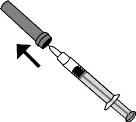
Ненатискайте на поршень до введення лікарського засобу. Після видалення ковпачка не чіпайте нічого голкою. Таким чином ви забезпечите, що голка залишається чистою (стерильною).
- Тримайте шприц рукою, якою ви пишете (як би це був олівець), та іншою рукою пом'якшуйте місце живота між вказівним та великим пальцями, щоб утворити складку шкіри.
Перевірте, що тримаєте складку шкіри протягом усього введення.
- Тримайте шприц так, щоб голка вказувала вниз (вертикально під кутом 90 градусів). Введіть всю голку у складку шкіри.
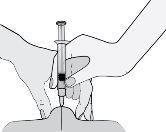
- Натискайте на поршень великим пальцем. Таким чином ви введете лікарський засіб у жирову тканину живота. Перевірте, що тримаєте складку шкіри протягом усього введення.
- Видаліть голку, потягнувши її прямо.
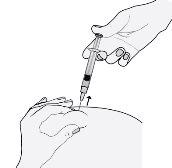
Щоб уникнути появи гематоми, не тертіте місце введення після введення лікарського засобу.
- Помістіть використаний шприц у контейнер для колючих предметів. Закрийте кришку контейнеру та помістіть його поза зоною досяжності дітей.
Коли контейнер буде повний, видаліть його так, як вказав ваш лікар або фармацевт. Не викидайте його у сміттєвий бак.
Самостійне введення ін'єкції Інхіксу за допомогою предварительно заповненої шприцу з захистом голки
Ваш предварительно заповнений шприц містить захист голки, щоб захистити вас від уколу голкою.
Якщо ви можете самостійно вводити цей лікарський засіб, ваш лікар або медсестра покажуть вам, як це зробити. Не намагайтесь самостійно вводити ін'єкцію, якщо вам не показали, як це зробити. Якщо ви не знаєте, що потрібно зробити, негайно проконсультуйтеся з лікарем або медсестрою.
Перед введенням Інхіксу
- Перевірте термін придатності лікарського засобу. Якщо він закінчився, не використовуйте його.
- Перевірте, чи не пошкоджена шприц і чи прозорий рідини всередині. В іншому випадку використовуйте іншу шприц.
- Не використовуйте цей лікарський засіб, якщо ви помітили будь-які зміни в його зовнішньому вигляді.
- Перевірте кількість лікарського засобу, який буде введено.
- Перегляньте, чи не викликала остання ін'єкція червоність, зміну кольору шкіри, набряк, гноєння або болючість. Якщо так, проконсультуйтеся з лікарем або медсестрою.
- Визначте місце введення лікарського засобу. Відмінюйте кожен раз сторону живота (шлунка) з правої на ліву. Цей лікарський засіб потрібно вводити прямо під шкіру живота, але не дуже близько до пупка або будь-якої шрами (не менше 5 см від них).
- Предварительно заповнена шприц призначена для одного використання.
Інструкції для самостійного введення Інхіксу
- Вимийте руки та місце введення водою та мильним розчином. Висушіть їх.
- Сядьте або лежіть у зручному та розслабленому положенні. Перевірте, чи можете побачити місце введення. Найбільш підходить диван, крісло-качалка або ліжко з подушками для підтримки.
- Виберіть місце на правій або лівій стороні живота. Воно повинно бути не менше 5 см від пупка та ближче до боків.
Пам'ятайте.Не вводіть лікарський засіб у радіусі 5 см навколо пупка або шрамів чи синяків, які можуть бути. Вводьте лікарський засіб у протилежну сторону від попередньої ін'єкції (відмінюючи праву сторону живота на ліву).
- Видаліть з коробки пластикову блистерну упаковку, яка містить предварительно заповнену шприц. Відкрийте блистер та витягніть шприц.
- Акуратно видаліть захисний ковпачок з голки шприцу, потягнувши за нього. Шприц предварительно заповнено та готовий до використання.
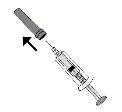
Ненатискайте на поршень до введення лікарського засобу. Після видалення ковпачка не чіпайте нічого голкою. Таким чином ви забезпечите, що голка залишається чистою (стерильною).
- Тримайте шприц рукою, якою ви пишете (як би це був олівець), та іншою рукою пом'якшуйте місце живота між вказівним та великим пальцями, щоб утворити складку шкіри.
Перевірте, що тримаєте складку шкіри протягом усього введення.
- Тримайте шприц так, щоб голка вказувала вниз (вертикально під кутом 90 градусів). Введіть всю голку у складку шкіри.
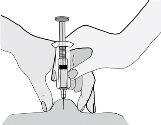
- Натискайте на поршень великим пальцем. Таким чином ви введете лікарський засіб у жирову тканину живота. Перевірте, що тримаєте складку шкіри протягом усього введення.
- Видаліть голку, потягнувши її прямо. Не зупиняйте натискання на поршень!
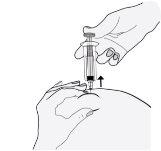
Щоб уникнути появи гематоми, не тертіте місце введення після введення лікарського засобу.
- Відпустіть поршень та дозвольте шприцу рухатися вгору, поки вся голка не буде захована та заблокована на місці.
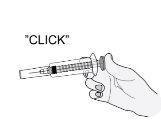
- Помістіть використаний шприц у контейнер для колючих предметів. Закрийте кришку контейнеру та помістіть його поза зоною досяжності дітей.
Коли контейнер буде повний, видаліть його так, як вказав ваш лікар або фармацевт. Не викидайте його у сміттєвий бак.
Зміна лікування антикоагулянтами
- Зміна Інхіксу на лікарські засоби для зменшення згортання крові, що називаються антагоністами вітаміну К (наприклад, варфарин)
Ваш лікар попросить зробити аналіз крові на наявність параметра, який називається МНР, та скаже, коли потрібно припинити лікування Інхіксом.
- Зміна лікарських засобів для зменшення згортання крові, що називаються антагоністами вітаміну К (наприклад, варфарин), на Інхікс
Припиніть використання антагоніста вітаміну К. Ваш лікар попросить зробити аналіз крові на наявність параметра, який називається МНР, та скаже, коли потрібно почати використовувати Інхікс.
- Зміна Інхіксу на лікування антикоагулянтами перорально (наприклад, апіксабан, дабігатран, едоксабан, ривароксабан)
Припиніть використання Інхіксу. Почніть приймати антикоагулянт перорально за 0-2 години до того, як вам потрібно буде зробити наступну ін'єкцію Інхіксу, та продовжуйте як зазвичай.
- Зміна лікування антикоагулянтами перорально на Інхікс
Припиніть приймати антикоагулянт перорально. Не починайте лікування Інхіксом до тих пір, поки не мине 12 годин після останньої дози антикоагулянту перорально.
Якщо ви використали більше Інхіксу, ніж потрібно
Якщо ви вважаєте, що використали надто велику кількість Інхіксу або надто малу, негайно повідомте про це вашого лікаря, медсестру або фармацевта, навіть якщо ви не відчуваєте жодних проблем. Якщо дитина випадково ввела собі Інхікс або прийняла його всередину, негайно доставьте її до відділення невідкладної допомоги лікарні.
Якщо ви забули використати Інхікс
Якщо ви забули зробити ін'єкцію, зробіть її якнайшвидше, коли ви про це пам'ятайте. Не використовуйте подвійну дозу в один і той же день, щоб компенсувати забуті дози. Щоб вам не забути жодної дози, можете використовувати щоденник.
Якщо ви припинили лікування Інхіксом
Якщо в вас є будь-які інші питання щодо використання цього лікарського засобу, проконсультуйтеся з лікарем, фармацевтом або медсестрою. важливо, щоб ви продовжували приймати Інхікс до тих пір, поки ваш лікар не вирішить припинити лікування. Якщо ви припините лікування, може утворитися кров'яний згусток, що може бути дуже небезпечним.
4. Можливі побічні ефекти
Як і всі лікарські засоби, цей лікарський засіб може викликати побічні ефекти, хоча не всі їх відчувають.
Як і інші антикоагулянти (лікарські засоби для зменшення кров'яних згустків), Інгікса могла б викликати кровотечу, що потенційно могла б загрожувати вашому життю. У деяких випадках кровотеча могла б бути неочевидною.
Якщо ви помітите будь-який епізод кровотечі, який не зупиняється сам собою, або якщо ви помітите ознаки надмірної кровотечі (ненормальна слабкість, втома, блідість, головокружіння, головний біль або необяснене набухання), негайно зверніться до свого лікаря.
Ваш лікар міг вирішити тримати вас під суворим спостереженням або змінити ваш лікарський засіб.
Перервіть лікування Інгіксою та негайно повідомте свого лікаря або медсестру, якщо ви відчуваєте будь-які ознаки сильної алергічної реакції (такі як труднощі з диханням, набухання губ, рота, горла чи очей).
Перервіть лікування еноксапарином та негайно повідомте свого лікаря або медсестру, якщо ви відчуваєте будь-які з наступних симптомів:
- Розповсюджена червона та лущена висипка, з підшкірними вузлами та пухирями, супроводжувана лихоманкою. Симптоми зазвичай з'являються на початку лікування (гостра пустулозна екзантема).
Ви повинні негайно повідомити свого лікаря
- Якщо ви маєте будь-які ознаки блокування кров'яного судини кров'яним згустком, такі як:
біль, подібний до судом, червоність, тепло чи набухання в одній з ваших ніг – це симптоми глибокої венозної тромбози
труднощі з диханням, біль у грудях, непритомність або кашель з кров'ю – це симптоми легеневого тромбоемболізму
- Якщо у вас є болюча висипка з темно-червоними точками під шкірою, які не зникають при натисненні.
Ваш лікар міг запросити проведення аналізу крові для перевірки кількості тромбоцитів.
Загальний перелік можливих побічних ефектів:
Дуже часті (можуть впливати на понад 1 з 10 осіб)
- Кровотеча.
- Збільшення активності печінкових ферментів.
Часті (можуть впливати до 1 з 10 осіб)
- Якщо з'являються синяки з більшою частотою, ніж зазвичай. Це могло б бути пов'язано з проблемами крові через низьку кількість тромбоцитів.
- Червоні плями на шкірі. Вони з'являються з більшою частотою в місці, де вам ввели Інгіксу.
- Висипка на шкірі (кропив'янка, уртикарія).
- Червоність і свербіж шкіри.
- Синяк або біль у місці ін'єкції.
- Зниження кількості червоних кров'яних тілечок у крові.
- Збільшення кількості тромбоцитів у крові.
- Головний біль.
Менш часті (можуть впливати до 1 з 100 осіб)
- Раптовий сильний головний біль. Це могло б бути ознакою кровотечі в мозку.
- Чуття чутливості при пальпації та набухання живота. Це могло б бути ознакою гастрічної кровотечі.
- Червоні великі плями на шкірі, неправильної форми з або без пухирів.
- Іритація шкіри (локальна іритація).
- Жовтіння шкіри чи очей, а також потемніння кольору сечі. Це могло б бути ознакою проблеми з печінкою.
Рідкі (можуть впливати до 1 з 1000 осіб)
- Сильна алергічна реакція. Ознаки цієї реакції могли б включати: висипка на шкірі, проблеми з ковтанням чи диханням, набухання губ, обличчя, горла чи язика.
- Збільшення рівня калію у крові. Це більш ймовірно у осіб з проблемами нирок чи цукровим діабетом. Ваш лікар міг би перевірити це шляхом проведення аналізу крові.
- Збільшення кількості білих кров'яних тілечок, званих еозинофілами, у крові. Ваш лікар міг би перевірити це шляхом проведення аналізу крові.
- Втата волосся.
- Остеопороз (хвороба, при якій кістки можуть ламатися з більшою ймовірністю).
- Оніміння, слабкість і безсилля у м'язах (особливо у нижній частині тіла) після проведення лумбальної пункції чи спінальної анестезії.
- Втрата контролю над сечовим міхуром чи кишківником (так, що ви не можете контролювати свої потреби).
- Затвердіння чи вузол у місці ін'єкції.
Звітність про побічні ефекти
Якщо ви відчуваєте будь-який побічний ефект, зверніться до свого лікаря або фармацевта, навіть якщо це можливі побічні ефекти, які не перелічені в цьому листку.
5. Зберігання Інгікси
Тримайте цей лікарський засіб поза зоною видимості та досягнення дітей.
Не використовуйте цей лікарський засіб після закінчення терміну придатності, вказаного на етикетці та коробці. Термін придатності – останній день місяця, який вказано.
Зберігайте при температурі нижче 25°C. Не заморожуйте.
Розчин слід використовувати протягом 8 годин після його розведення.
Не використовуйте цей лікарський засіб, якщо ви помітите будь-які видимі зміни у вигляді розчину.
Предварительно наповнені шприци Інгікси призначені лише для одного використання. Вийміть невикористаний лікарський засіб.
Лікарські засоби не слід викидати у водопровідні труби чи сміття. Спитайте свого фармацевта, як позбутися упаковок та лікарських засобів, які вам більше не потрібні. Таким чином, ви допоможете захистити довкілля.
6. Зміст упаковки та додаткова інформація
Склад Інгікси
- Активний інгредієнт – еноксапарин натрію.
Кожен мілілітр містить 15 000 ОД (150 мг) еноксапарину натрію.
Кожен попередньо наповнений шприц об'ємом 0,8 мл містить 12 000 ОД (120 мг) еноксапарину натрію.
Кожен попередньо наповнений шприц об'ємом 1 мл містить 15 000 ОД (150 мг) еноксапарину натрію.
- Інші компоненти – вода для ін'єкційних препаратів.
Вигляд продукту та вміст упаковки
Інгікса 12 000 ОД (120 мг)/0,8 мл – 0,8 мл розчину, вміщеного у:
- склошприц прозорий, безбарвний, нейтральний та типу I, з фіксованою голкою та захисником голки, закритим пробкою з хлоробутилової гуми та поршнем з поліпропілену червоного кольору. Шприц можна додатково оснастити захисником голки.
Цей лікарський засіб випускається в упаковках:
- по 2, 10 та 30 попередньо наповнених шприців
- по 10 та 30 попередньо наповнених шприців із захисником голки
Інгікса 15 000 ОД (150 мг)/1 мл – 1 мл розчину, вміщеного у:
- склошприц прозорий, безбарвний, нейтральний та типу I, з фіксованою голкою та захисником голки, закритим пробкою з хлоробутилової гуми та поршнем з поліпропілену темно-синього кольору. Шприц можна додатково оснастити захисником голки.
Цей лікарський засіб випускається в упаковках:
- по 2, 10 та 30 попередньо наповнених шприців
- по 10 та 30 попередньо наповнених шприців із захисником голки
Можливо, що тільки деякі розміри упаковок будуть випускатися.
Уповноважений на отримання дозволу на розміщення лікарського засобу на ринку та відповідальний за виробництво
Уповноважений на отримання дозволу на розміщення лікарського засобу на ринку
Techdow Pharma Netherlands B.V.
Strawinskylaan 1143, Toren C-11
1077XX Amsterdam
Нідерланди
Відповідальний за виробництво
SciencePharma spólka z ograniczona odpowiedzialnoscia
Chelmska 30/34
00-725 Варшава
Польща
Ви можете запитати додаткову інформацію про цей лікарський засіб, звернувшись до місцевого представника уповноваженого на отримання дозволу на розміщення лікарського засобу на ринку:
Бельгія Techdow Pharma Netherlands B.V.+31 (0)76 531 5388 | Литва Techdow Pharma Netherlands B.V. +37125892152 |
| Люксембург Techdow Pharma Netherlands B.V. +49 (0)30 220 13 6906 |
Чехія Techdow Pharma Netherlands B.V. +420255790502 | Угорщина Techdow Pharma Netherlands B.V. +3618001930 |
Данія Techdow Pharma Netherlands B.V. +4578774377 | Мальта Mint Health Ltd +441483928995 |
Німеччина Мітвертрейб: Techdow Pharma Germany GmbH Potsdamer Platz 1, 10785 Берлін +49 (0)30 98 321 31 00 | Нідерланди Techdow Pharma Netherlands B.V. +31208081112 |
Естонія Techdow Pharma Netherlands B.V. +37125892152 | Норвегія Techdow Pharma Netherlands B.V. +4721569855 |
Греція Techdow Pharma Netherlands B.V. +49 (0)30 220 13 6906 | Австрія Techdow Pharma Netherlands B.V. +43720230772 |
Іспанія TECHDOW PHARMA SPAIN, S.L. Тел: +34 91 123 21 16 | Польща Techdow Pharma Netherlands B.V. +49 (0)30 220 13 6906 |
Франція Viatris Santé +33 4 37 25 75 00 | Португалія Laboratórios Atral, S.A. +351308801067 |
Хорватія Techdow Pharma Netherlands B.V. +385 17776255 Ірландія Techdow Pharma England Ltd +441483928995 | Румунія Techdow Pharma Netherlands B.V. +49 (0)30 220 13 6906 Словенія Techdow Pharma Netherlands B.V. +49 (0)30 220 13 6906 |
Ісландія Techdow Pharma Netherlands B.V. +49 (0)30 220 13 6906 | Словаччина Techdow Pharma Netherlands B.V. +421233331071 |
Італія Techdow Pharma Italy S.R.L. Тел: +39 0256569157 | Фінляндія Techdow Pharma Netherlands B.V. +358942733040 |
Кіпр MA Pharmaceuticals Trading Ltd +357 25 587112 | Швеція Techdow Pharma Netherlands B.V. +46184445720 |
Латвія Techdow Pharma Netherlands B.V. +37125892152 | Велика Британія(Північна Ірландія) Techdow Pharma Netherlands B.V + 44 28 9279 2030 |
Дата останнього перегляду цього листка:
Інші джерела інформації
Детальна інформація про цей лікарський засіб доступна на сайті Європейського агентства з лікарських засобів: http://www.ema.europa.eu.

Скільки коштує ІНІКСА 15 000 МО (150 мг)/1 мл розчин для ін'єкцій в Іспанії у 2025 році?
ІНІКСА 15 000 МО (150 мг)/1 мл розчин для ін'єкцій коштує в середньому 267.9 євро у грудень, 2025 році. Ціна може змінюватися залежно від регіону, аптеки та наявності рецепта. Рекомендуємо перевіряти актуальну вартість у місцевих аптеках або через онлайн-сервіси.
- Країна реєстрації
- Середня ціна в аптеках267.9 EUR
- Діючі речовини
- Потрібен рецептТак
- Виробник
- Інформація є довідковою і не є медичною порадою. Перед прийомом будь-яких препаратів обов'язково проконсультуйтеся з лікарем. Oladoctor не несе відповідальності за медичні рішення, прийняті на основі цього контенту.
- Альтернативи до ІНІКСА 15 000 МО (150 мг)/1 мл розчин для ін'єкційФорма випуску: РОЗЧИН ДЛЯ ІН'ЄКЦІЙ, 100 мг (10000 МО) еноксапарину натрію/млДіючі речовини: enoxaparinВиробник: Sanofi Aventis S.A.Потрібен рецептФорма випуску: РОЗЧИН ДЛЯ ІН'ЄКЦІЙ, 120 мг (12000 МО) /0,8 млДіючі речовини: enoxaparinВиробник: Sanofi Aventis S.A.Потрібен рецептФорма випуску: РОЗЧИН ДЛЯ ІН'ЄКЦІЙ, 150 мг (15000 МО) /1 млДіючі речовини: enoxaparinВиробник: Sanofi Aventis S.A.Потрібен рецепт
Аналоги ІНІКСА 15 000 МО (150 мг)/1 мл розчин для ін'єкцій в інших країнах
Найкращі аналоги з тією самою діючою речовиною та терапевтичним ефектом.
Аналог ІНІКСА 15 000 МО (150 мг)/1 мл розчин для ін'єкцій у Polonia
Аналог ІНІКСА 15 000 МО (150 мг)/1 мл розчин для ін'єкцій у Ucrania
Лікарі онлайн щодо ІНІКСА 15 000 МО (150 мг)/1 мл розчин для ін'єкцій
Консультація щодо дозування, побічних ефектів, взаємодій, протипоказань та поновлення рецепта на ІНІКСА 15 000 МО (150 мг)/1 мл розчин для ін'єкцій – за рішенням лікаря та згідно з місцевими правилами.















